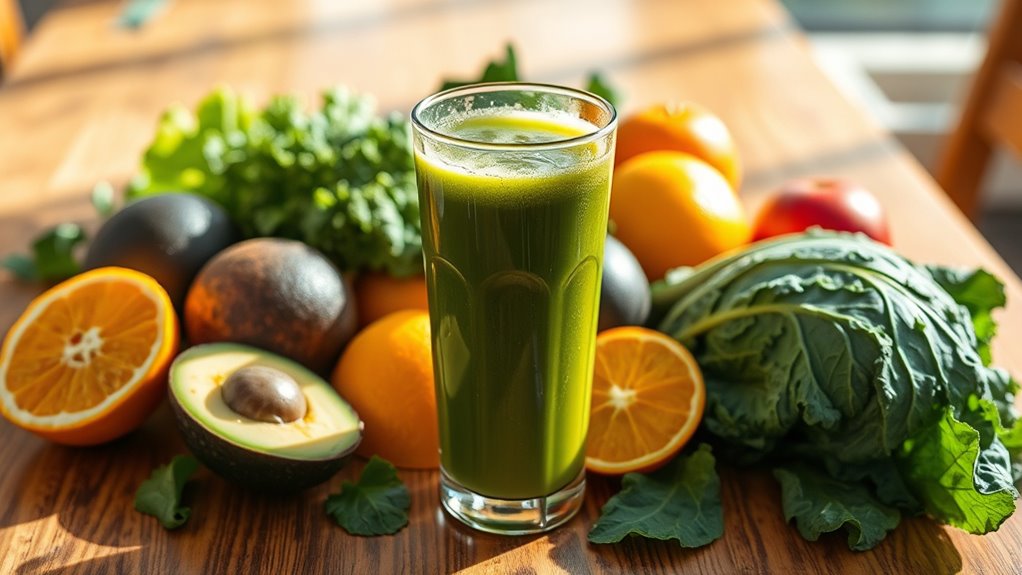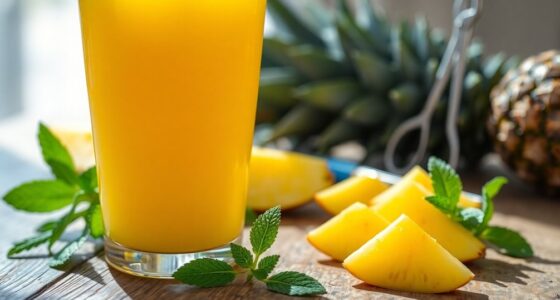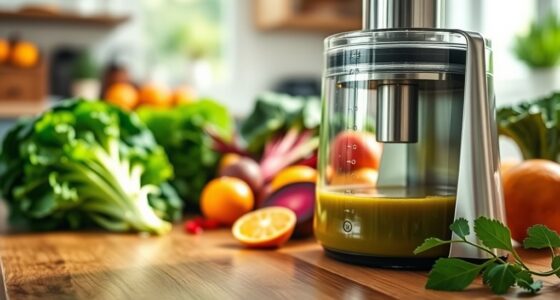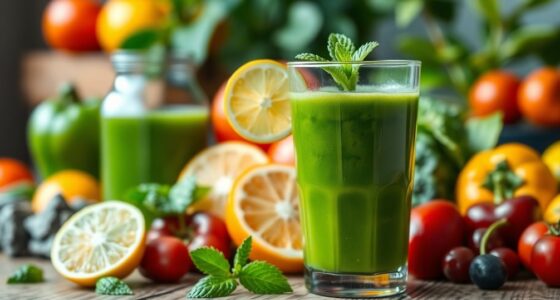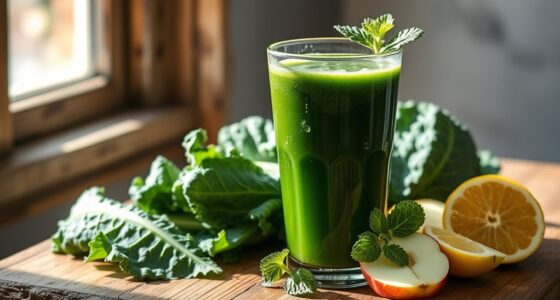Juicing can impact your blood sugar levels considerably, so it’s essential to choose wisely. While juices can offer vitamins, they often lack fiber, leading to rapid sugar absorption. Opt for low-carb vegetable juices or 100% fruit options, and keep portions small to avoid spikes. Combine juices with protein or healthy fats for better blood sugar control. Understanding the balance between juice and whole fruits plays a key role in diabetes management, which you’ll want to explore further.
Key Takeaways
- Juicing can spike blood sugar quickly due to the absence of fiber, making whole fruits a better choice for diabetes management.
- Opt for low-carb vegetable juices and avoid those with added sugars to keep blood sugar levels stable.
- Portion control is crucial; limit juice intake to small servings, such as half a cup of 100% fruit juice.
- Combining juice with protein or healthy fats can help mitigate blood sugar spikes and improve overall management.
- Regularly monitor blood sugar levels before and after juice consumption to assess individual tolerance and adjust dietary choices accordingly.
Understanding Juicing and Its Impact on Blood Sugar
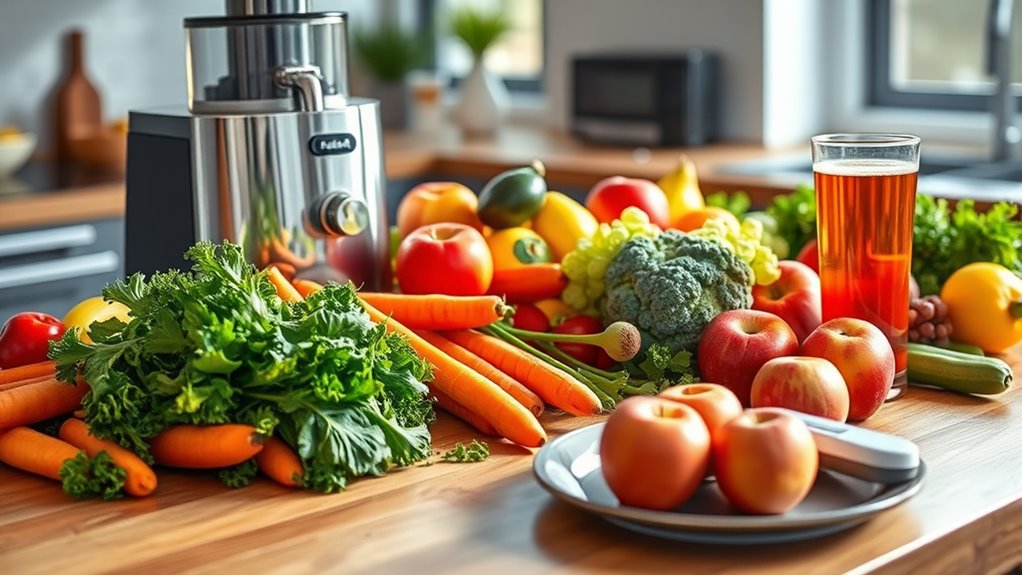
When you consider juicing as part of your diabetes management, it’s important to understand how it affects your blood sugar levels.
Drinking juice often extracts sugars from fruits and vegetables while removing fiber, leading to quicker absorption and potential spikes in blood sugar levels. For instance, an eight-ounce serving of fruit juice can contain around 30 grams of sugar—similar to sugary beverages like soda.
Juicing removes fiber, causing quicker sugar absorption and potential blood sugar spikes, similar to sugary drinks.
In contrast, whole fruits promote slower blood sugar increases due to their fiber content. If you’re managing diabetes, monitoring your blood sugar levels before and after consuming juices is essential.
Opting for vegetable juices made from low-carb options without added sugars may be a better choice for keeping your blood sugar levels in check.
The Nutritional Benefits and Drawbacks of Juicing
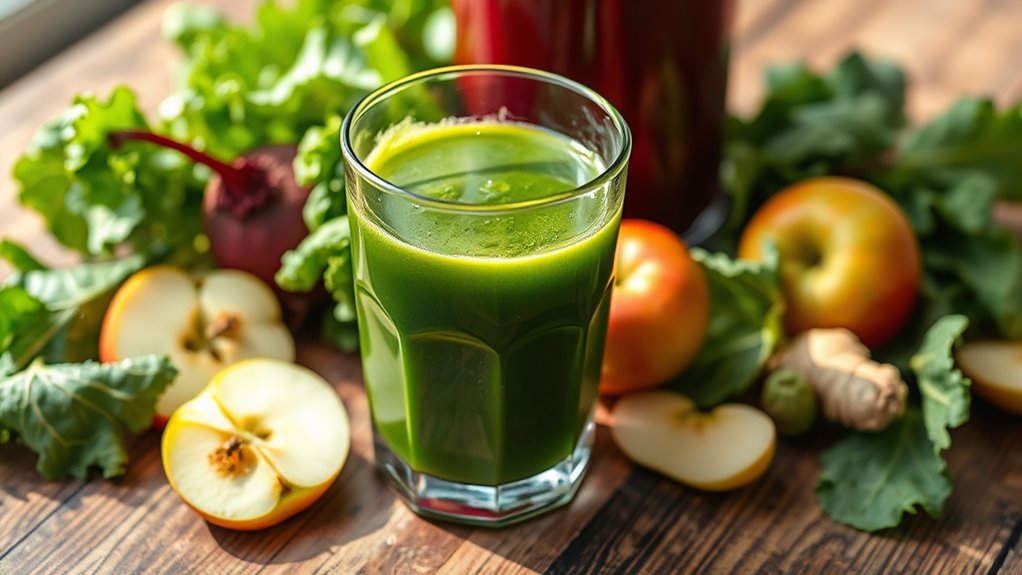
Juicing can pack a powerful punch of vitamins and minerals, but it often strips away the fiber that slows sugar absorption.
This loss can lead to quick spikes in blood sugar, making whole fruits a better option for managing diabetes.
While vegetable juices offer a lower-sugar alternative, it’s essential to enjoy them in moderation to keep your overall sugar intake in check.
Nutrient Density in Juices
Although juicing can boost your intake of essential vitamins and minerals, it’s crucial to be aware of its potential drawbacks, especially for those managing diabetes.
Juices often have high sugar content, which can spike blood glucose levels. Here are some points to take into account:
- Most fruit juices contain about 30 grams of sugar per 8-ounce serving, similar to soda.
- Vegetable juices are generally lower in sugar but may have high sodium levels.
- While juices offer quick access to nutrients, they lack the fiber found in whole fruits and vegetables, which is necessary for blood sugar stability.
For maximum health benefits, focus on low-sugar vegetable juices and consume them in moderation to help manage your diabetes effectively. Additionally, suitable fruit juice varieties like tomato and lemon can provide health benefits without significantly impacting blood sugar levels.
Fiber Loss in Juicing
While you might enjoy the quick boost of nutrients that juicing provides, it’s important to recognize the significant fiber loss that occurs in the process. This fiber is essential for slowing down sugar absorption and promoting satiety, which helps manage blood sugar levels. Without it, fruit juices can be high in sugar, comparable to sugary sodas. Whole fruits, on the other hand, maintain their fiber content, enhancing their nutritional profile and effectiveness in diabetes management. Here’s a quick comparison:
| Type | Fiber Content | Sugar Content |
|---|---|---|
| Whole Fruits | High | Moderate |
| Fruit Juices | Low | High |
| Sugary Sodas | None | High |
Consider eating them whole for better blood sugar control! Additionally, juice cleanses can lead to nutrient deficiencies if practiced for extended periods, which is a critical concern for those managing diabetes.
Blood Sugar Impacts
Understanding the blood sugar impacts of juicing is essential, especially if you’re managing diabetes. When you drink juice, you’re often consuming a high amount of sugar without the beneficial fiber found in whole fruits and vegetables. This can lead to quick sugar absorption and high blood sugar spikes.
Here are some key points to reflect on:
- An eight-ounce glass of fruit juice contains about 30 grams of sugar, similar to a sugary soda.
- Even small portions, like 4 ounces, can add 12-15 grams of carbs to your diet.
- Vegetable juices made from low-carb options may be a healthier choice.
For effective diabetes management, focus on whole fruits, monitor portion sizes, and be cautious with fruit juice.
Choosing Diabetes-Friendly Juice Options

When you’re looking for juice options that won’t spike your blood sugar, focus on low-carb fruits and non-starchy vegetables like cucumber and lemon. Always avoid juices with added sugars and opt for 100% juice products free of preservatives to boost health benefits.
Here’s a quick guide to diabetes-friendly juices:
| Juice Type | Sugar Content | Notes |
|---|---|---|
| Cucumber Juice | Low | Invigorating and hydrating |
| Lemon Juice | Low | Great for flavoring other drinks |
| Spinach Juice | Low | Packed with nutrients |
| Celery Juice | Low | Excellent for hydration |
| Avocado Smoothie | Moderate | Combine with low-carb fruits |
Combining juice with protein or healthy fats can help keep your blood sugar stable. Additionally, celery juice is known for its anti-inflammatory properties, making it a great choice for overall health. Always consult your diabetes educator for personalized advice!
Portion Control: How Much Juice Is Too Much?
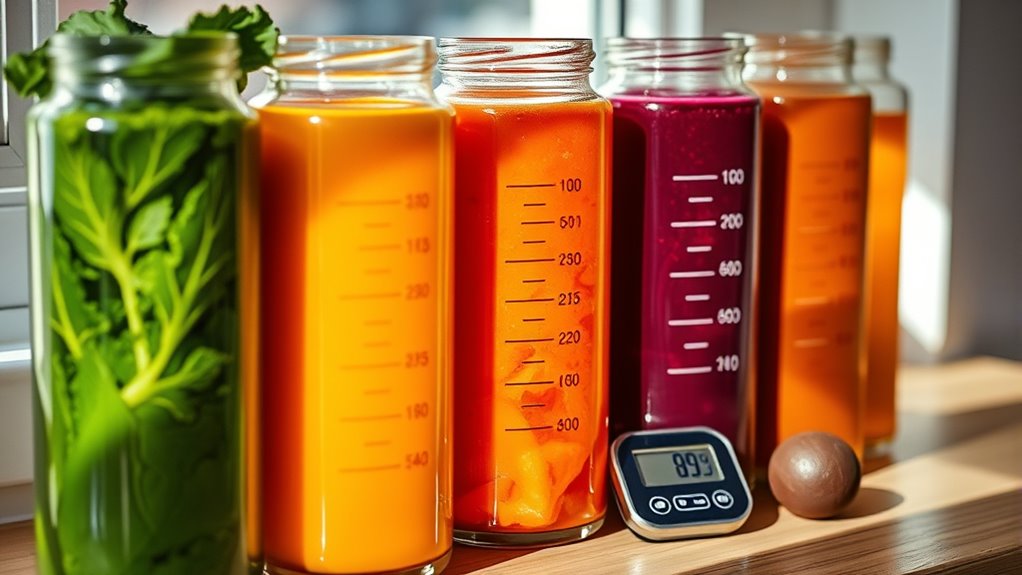
How can you enjoy juice without jeopardizing your blood sugar levels? Portion control is key for managing your sugar intake. When it comes to fruit juice, remember to stick to a serving size of about 4 to 5 ounces per day.
Here are some tips to help you:
- Limit juice to no more than 150ml daily to control blood sugar.
- Be aware that an 8-ounce serving can contain around 30 grams of sugar.
- Consider diluting juice with water or pairing it with protein or fat to balance carbohydrate content.
- Regular consumption of detoxifying juices can also support overall health and help regulate blood sugar levels.
Keeping these guidelines in mind can help you enjoy juice while minimizing the risk of blood sugar spikes, essential for anyone managing diabetes.
Enhancing Juices With Nutritional Balance
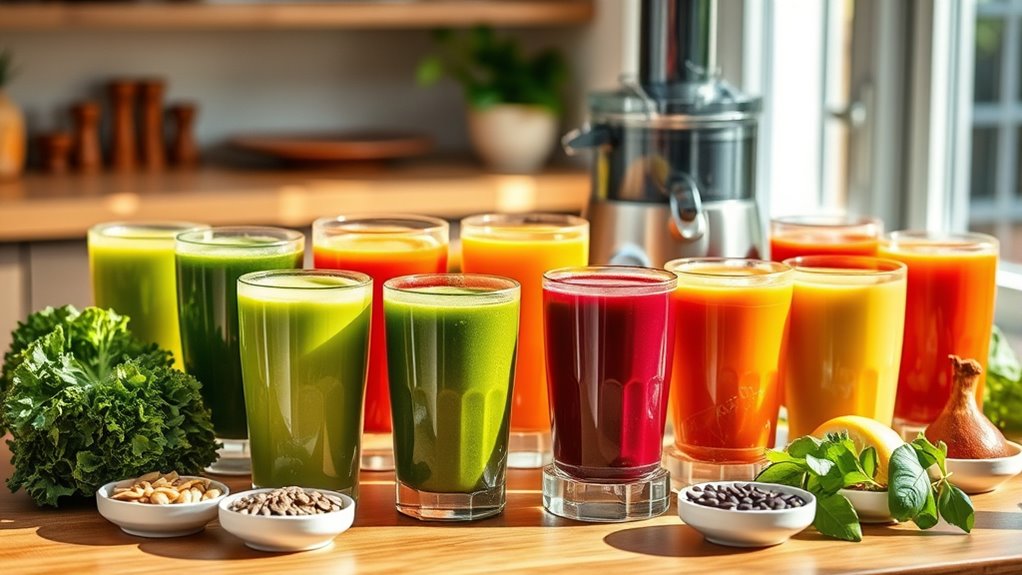
Enjoying juice while managing diabetes goes beyond portion control; it’s also about enhancing the nutritional balance of what you drink. Mixing low-carb vegetables like cucumber or spinach with fruit and vegetable juices minimizes sugar content and aids blood sugar control. Consider the table below for ideas:
| Ingredient Type | Examples | Benefits |
|---|---|---|
| Protein Sources | Greek yogurt, protein powder | Stabilizes blood sugar |
| Healthy Fats | Avocado, nut butter | Improves satiety |
| Dilution Options | Water, carbonated water | Lowers carbohydrate content |
Incorporating high-fiber ingredients into your juices can further improve blood sugar regulation and overall health.
The Role of Whole Fruits Versus Juice
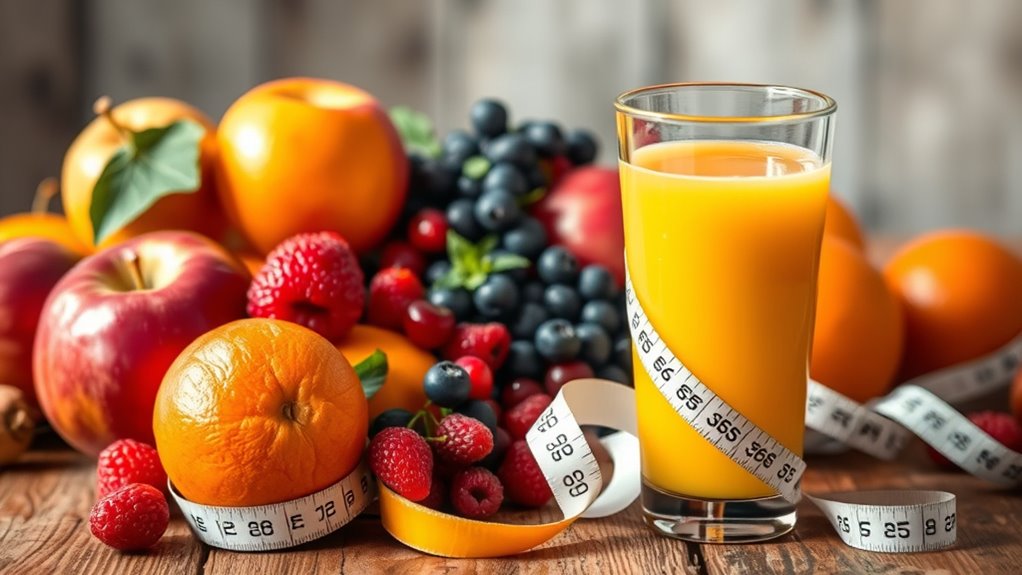
While both whole fruits and fruit juices can be part of a healthy diet, choosing whole fruits is essential for managing diabetes effectively. Whole fruits contain fiber, which slows down sugar absorption, helping maintain stable blood sugar levels. In contrast, fruit juice often leads to rapid sugar spikes.
- Whole fruits reduce free sugar intake, aiding in type 2 diabetes prevention.
- They provide essential vitamins, minerals, and phytochemicals that enhance overall health.
- Eating whole fruits increases satiety, reducing the likelihood of overeating.
Incorporating low carb high protein breakfasts can also help stabilize blood sugar levels throughout the day.
Managing Low Blood Sugar With Juice
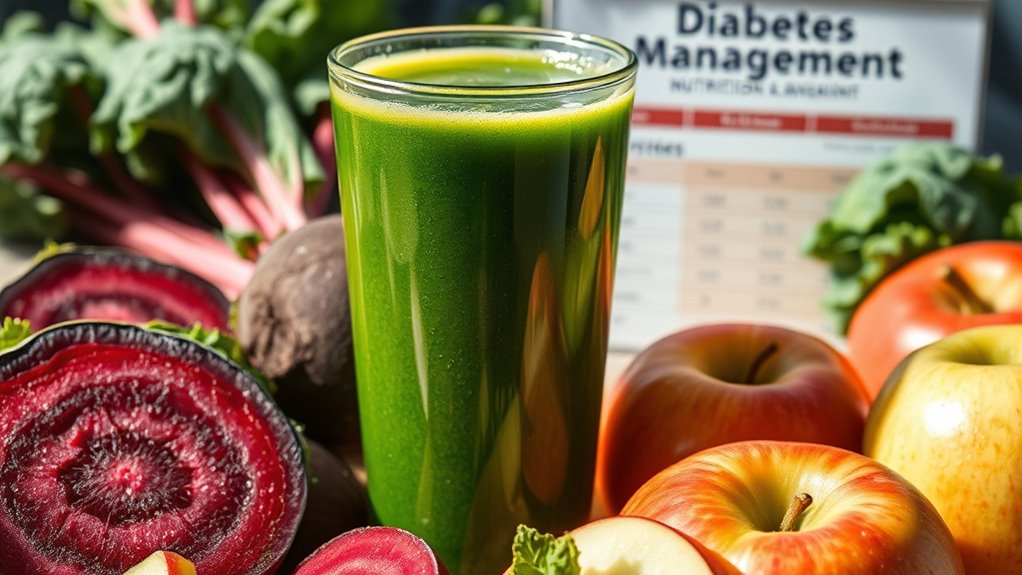
When managing low blood sugar, juice can be a quick and effective solution. For people with diabetes, drinking a small amount of juice, like half a cup of 100% fruit juice, can help raise blood sugar levels rapidly, following the “15-15 rule.”
However, portion control is vital; you should monitor your blood sugar after consumption to avoid overshooting your levels. Pulp-free options, such as apple or grape juice, are often recommended for better results.
While scientific evidence supports juice as a useful tool during low episodes, it’s important to remember that you shouldn’t rely on it as a primary treatment or make it a regular part of your diet. In some cases, glucose tablets may be more effective.
Expert Insights on Juicing and Diabetes
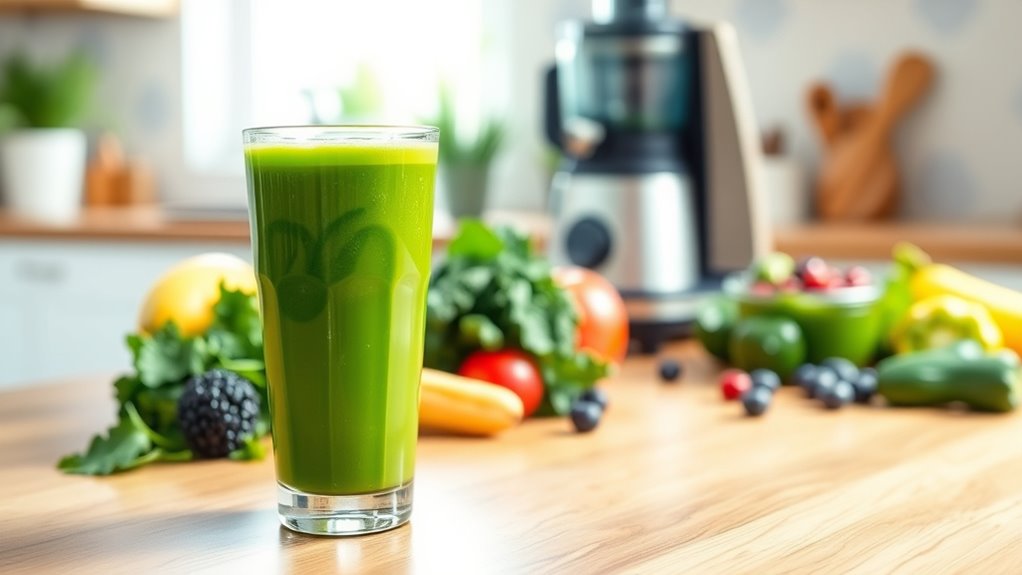
Managing low blood sugar with juice can be effective, but it raises the question of how juice fits into a broader diabetes management plan.
Experts suggest that juice isn’t a forbidden food; it can be included if you make smart decisions about portion size and ingredients. Here are some key points to take into account:
Juice can be part of a diabetes management plan when chosen wisely regarding portion sizes and ingredients.
- Use juices made from lower-carb vegetables mixed with small amounts of whole fruit to minimize blood sugar spikes.
- Always monitor your blood sugar levels before and after consuming juice to understand your tolerance.
- Don’t replace whole fruits and vegetables with juice; whole foods provide essential fiber for balanced nutrition.
Consulting with healthcare professionals guarantees you maintain both blood sugar control and a nutritious diet.
Frequently Asked Questions
Is Juicing Good for Someone With Diabetes?
Juicing can be tricky for you if you have diabetes. While it offers vitamins, many fruit juices are high in sugar and can spike your blood sugar levels quickly.
Instead, consider vegetable juices made from low-carb ingredients like leafy greens or cucumbers. They provide nutrients with less sugar.
It’s smart to consult with a dietitian to create a personalized plan that considers your blood sugar responses and overall dietary needs.
What Is the Fastest Way to Reverse Diabetes?
The fastest way to reverse diabetes is by making significant lifestyle changes.
Start by adopting a low-carb, high-fiber diet filled with whole fruits and vegetables while avoiding processed foods.
Regular exercise, including aerobic and resistance training, is essential for improving insulin sensitivity.
Aim to lose 5-10% of your body weight, as this can greatly enhance your blood sugar control.
Don’t forget to monitor your levels and consult with healthcare professionals for personalized guidance.
Which Is the Best Juice to Control Diabetes?
When it comes to controlling diabetes, think of vegetable juices as your secret garden, bursting with vibrant life.
You can’t go wrong with low-carb options like spinach, kale, or cucumber, as they nourish without the sugar spike.
Berries like blueberries and strawberries are your sweet allies, packed with antioxidants.
Just remember to keep portion sizes in check, and consider making your juices at home to dodge those sneaky added sugars.
Your health’s worth it!
What Drinks Flush Out Sugar in the Body?
To flush out sugar from your body, stay hydrated by drinking plenty of water.
Unsweetened herbal teas, especially those with dandelion or ginger, can support your liver and enhance sugar metabolism.
You might also try smoothies with leafy greens and low-sugar fruits to slow sugar absorption.
Additionally, drinking diluted apple cider vinegar before meals may improve insulin sensitivity.
Infused water with lemon or cucumber not only tastes great but helps manage your blood sugar too.
Conclusion
To sum up, juicing can be a useful tool for diabetes management, but it’s important to approach it wisely. Think of juice as a tasty sidekick, not the main hero in your diet. By choosing diabetes-friendly options, practicing portion control, and balancing your nutrients, you can enjoy the benefits without the risks. Always remember to prioritize whole fruits and consult with a healthcare professional to keep your blood sugar levels in check. Happy juicing!
Cindy thoroughly researches juicing trends, techniques, and recipes to provide readers with practical advice and inspiration. Her writing style is accessible, engaging, and designed to make complex concepts easy to understand. Cindy’s dedication to promoting the advantages of juicing shines through her work, empowering readers to make positive changes in their lives through the simple act of juicing.

